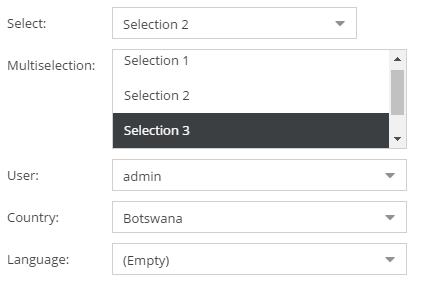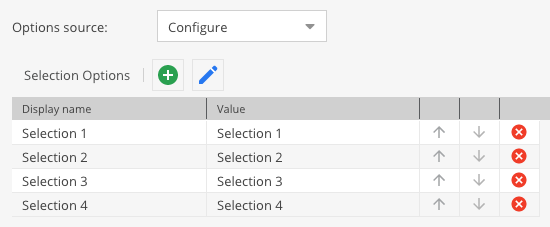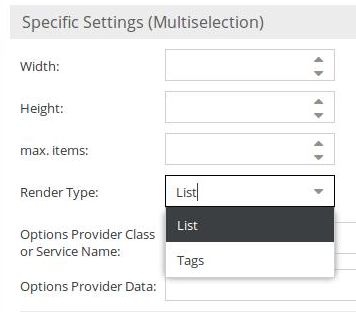Select Datatypes
There are 7 different select widgets available. Except the Multiselect widgets, all of them are portrayed by an input field with a drop-down list of options. The database column type is VARCHAR for all select data types, TEXT for all multiselection types. The configured value (not the display value!) is stored in the database. In the case of multiselect, values are stored as a comma separated list.
For select and multiselect the options can be defined with a value and display value in the class definition:
It's also possible to retrieve options from difference sources.
Country and language have fixed option values. For the language field the options can be limited to available system languages. The country and language select field are also available as multi select fields. The user field has fixed values as well. It allows to select a user from all available Pimcore system users. Thereby a system user can be associated an object.
For multiselect types there is extra configuration to set render type (list or tags)
Object Editor view for List Render Type:
Object Editor view for Tags Render Type:
Working with select data types via API
In order to set a select field's value programmatically, the value is simply passed to the setter. To set the values of a multiselect field, an array of values is passed to the setter.
$object->setSelect("1");
$object->setMultiselect(["1","2"]);
$object->setLanguage("en");
$object->setCountry("AU");
$object->setUser(1);
$object->save();
If one needs to find out what options are available for a select field. This can be done by getting the field definition as follows:
$fd = $object->getClass()->getFieldDefinition("multiselect");
$options = $fd->getOptions();
If one needs to find out what options are available for a select field inside an ObjectBrick. This can also be done by getting the field definition of the brick as follows:
$fd = $brick->getDefinition()->getFieldDefinition("multiselect");
$options = $fd->getOptions();
The display name values can be obtained as follows:
use Pimcore\Model\DataObject;
...
$o = DataObject::getById(49);
// for a (single) select data field
$valuesSingle = DataObject\Service::getOptionsForSelectField($o, "select");
$selectedValueSingle = $valuesSingle[$o->getSelect()];
// for a multiselect data field
$multiSelectFieldValues = DataObject\Service::getOptionsForMultiSelectField($o, "multiSelectField");
$selectedValues = array_map(
static fn($value) => $multiSelectFieldValues[$value],
$o->getMultiSelectField()
); // For PHP >= 7.4
$selectedValues = array_map(
static function($value) use ($multiSelectFieldValues) {
return $multiSelectFieldValues[$value];
}, $o->getMultiSelectField()
); // For PHP <= 7.3
To show the selected option's display name in a Twig template, first put the option values as a view variable inside the controller action:
use Pimcore\Model\DataObject;
...
$product = DataObject::getById(49);
// for a select data field
$colorOptions = DataObject\Service::getOptionsForSelectField($product, "color");
return $this->render('foo/bar.html.twig', ['colorOptions' => $colorOptions]);
Then you can use it in the Twig view:
{{ colorOptions[product.color] }}


